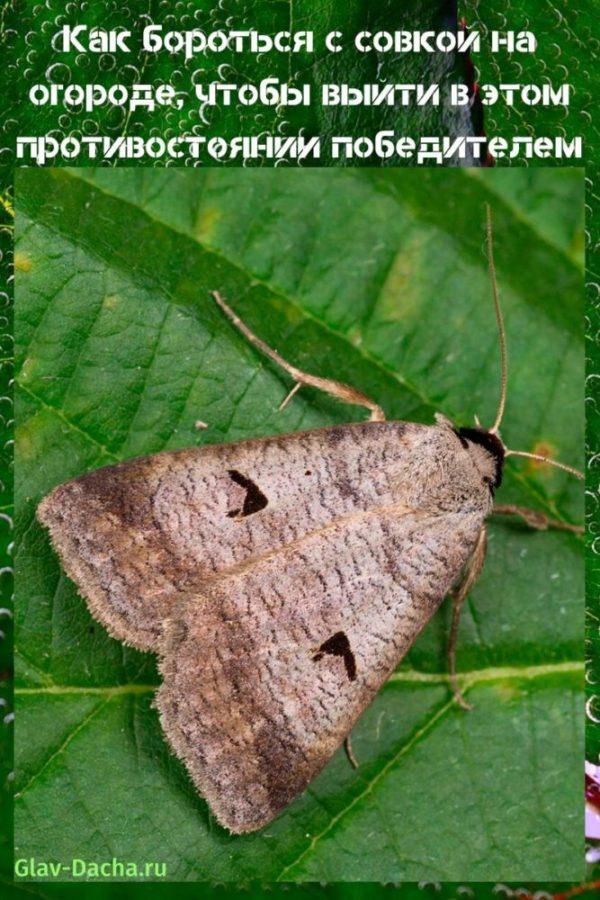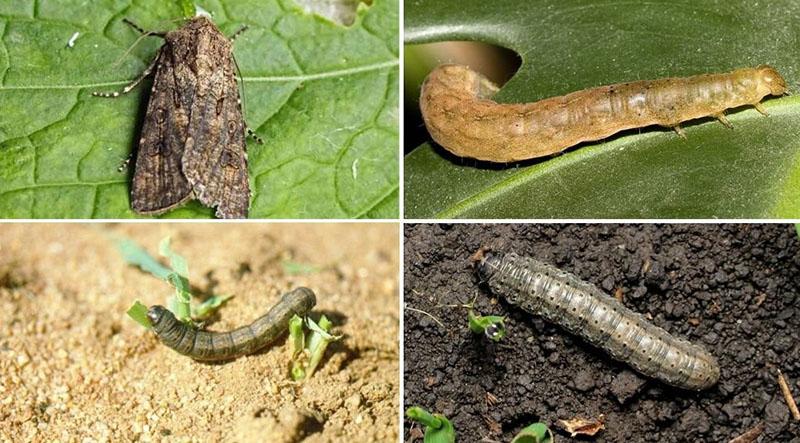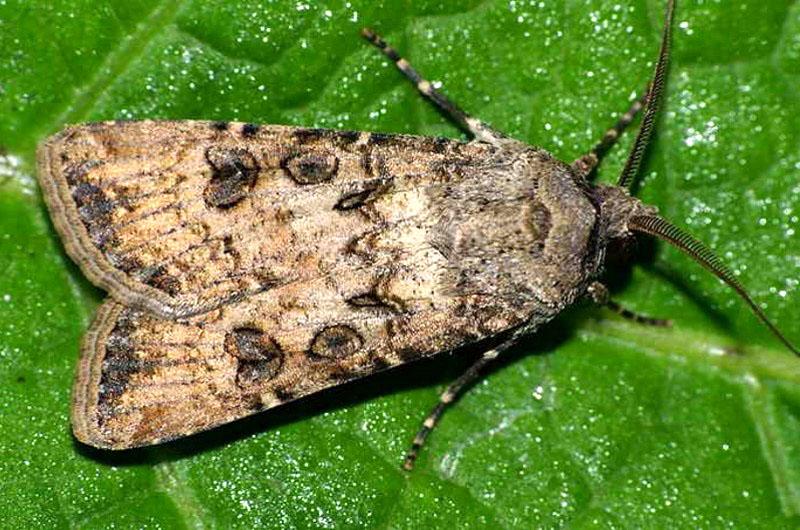How to deal with a scoop in the garden in order to emerge victorious in this confrontation
 No farmer wants his crops to be eaten by pests or their caterpillars. In this regard, each farmer tries to find a suitable method for how to deal with a scoop in the garden. Agrarians offer many options for solving the problem. Some use folk or agronomic techniques, others resort to potent chemicals or biologicals. Still, everyone has the right to decide for himself how to act in this situation.
No farmer wants his crops to be eaten by pests or their caterpillars. In this regard, each farmer tries to find a suitable method for how to deal with a scoop in the garden. Agrarians offer many options for solving the problem. Some use folk or agronomic techniques, others resort to potent chemicals or biologicals. Still, everyone has the right to decide for himself how to act in this situation.
Description of the pest and its diet

There are three main colors of the bat:
- gray-ash;
- dark brown;
- coffee brown.
The scoop is recognized as the most dangerous pest in the territory of the post-Soviet countries. Its menu includes about 40 cultivated crops.
 On the wings of some species, an original drawing is depicted, resembling a letter of the Greek alphabet - a scale. The rest of the genus surprise with chaotic "prints" in the form of longitudinal stripes of a contrasting shade. The lifespan of the scoop is one month. During this time, females manage to lay up to several hundred eggs on the back of the leaves. After 10-12 days, larvae hatch from them. It is these caterpillars that pose a threat to vegetable crops.
On the wings of some species, an original drawing is depicted, resembling a letter of the Greek alphabet - a scale. The rest of the genus surprise with chaotic "prints" in the form of longitudinal stripes of a contrasting shade. The lifespan of the scoop is one month. During this time, females manage to lay up to several hundred eggs on the back of the leaves. After 10-12 days, larvae hatch from them. It is these caterpillars that pose a threat to vegetable crops.
After birth, they immediately begin to feed on juice.:
- beets;
- carrots;
- cabbage;
- sunflower;
- peas;
- potatoes.
In the southern regions, the summer butterfly season opens in May, and in the northern regions, in mid-June.
 Lepidoptera begin to mate within the first 2-3 days, after emerging from pupae. The females then lay their eggs. One such clutch can contain up to 20-150 eggs. The total fertility of individuals per season is 600-2700 eggs. The appearance of the larvae varies from 4 to 12 days. The development of caterpillars is observed within 24-50 days.
Lepidoptera begin to mate within the first 2-3 days, after emerging from pupae. The females then lay their eggs. One such clutch can contain up to 20-150 eggs. The total fertility of individuals per season is 600-2700 eggs. The appearance of the larvae varies from 4 to 12 days. The development of caterpillars is observed within 24-50 days.
Learn to distinguish between the types of scoops
 Perhaps, this issue should be given special attention. Each species of bat affects different varieties of crops. Despite the fact that there are thousands of species all over the world, the gnawing scoop will be especially interesting for farmers. The methods of dealing with a representative of the Lepidoptera family are quite diverse.
Perhaps, this issue should be given special attention. Each species of bat affects different varieties of crops. Despite the fact that there are thousands of species all over the world, the gnawing scoop will be especially interesting for farmers. The methods of dealing with a representative of the Lepidoptera family are quite diverse.
But before you deal with them, it is necessary to determine one of the subspecies of insect pests:
- Exclamation scoop. Small ash-colored wings with black stripes in the form of an exclamation mark "!" up to 32-45 mm. The dark gray caterpillars are up to 30 mm long. Most often, seedlings of cabbage and carrots are affected. Lays eggs in late May. Up to 1-3 generations are produced per season.

- Winter. Ivory yellowish-gray. Thick tracks up to 50 mm long with a shiny bronze sheen. In one night, each individual damages dozens of plants.

- Potato scoop. The wingspan of the bat reaches 28-40 mm. They have a grayish tint with a slight yellow or brown undertone. They feature an abstract pattern, framed by a wide border. The dark-headed ocher-colored larvae grow up to 40-50 cm.

The garden scoop is a leaf-eating pest that lives on the soil surface.Moths are brown-brown in color and have a mosaic pattern. The larvae are most often light green or coffee-bronze.
Insects usually feed on:
- radish;
- peas;
- beans;
- cabbage;
- turnip;
- pepper;
- tomatoes.
Vital activity of butterflies occurs in the evening and at night. Lepidoptera hibernate in the soil at a depth of 10-25 cm.
 Another representative of the leaf-gnawing genus is the cabbage scoop. In span, its gray-brown wings reach 45-50 mm. Along the edges, the mosaic pattern acquires sharper outlines and resembles ruffles. The caterpillar goes through up to 5 stages of molting and 6 age transformations. It is distinguished by its light green or deep brown hue.
Another representative of the leaf-gnawing genus is the cabbage scoop. In span, its gray-brown wings reach 45-50 mm. Along the edges, the mosaic pattern acquires sharper outlines and resembles ruffles. The caterpillar goes through up to 5 stages of molting and 6 age transformations. It is distinguished by its light green or deep brown hue.
How to deal with a scoop in the garden using all known technologies
 There are several stages of caterpillar development. At an early age, they eat exclusively the lower foliage of the culture. At the 2nd and 3rd instars, they prefer the entire green mass of the plant, leaving only the veins. At the end of June, pupation begins. It is in this state that Lepidoptera go for the winter. Given these features of the life of pests, you can understand how to destroy the scoop in your garden. There are 3 common techniques.
There are several stages of caterpillar development. At an early age, they eat exclusively the lower foliage of the culture. At the 2nd and 3rd instars, they prefer the entire green mass of the plant, leaving only the veins. At the end of June, pupation begins. It is in this state that Lepidoptera go for the winter. Given these features of the life of pests, you can understand how to destroy the scoop in your garden. There are 3 common techniques.
Agricultural technology comes to the rescue
 Myotis pupae hibernate in the ground at a maximum depth of 30 cm (some species). In this regard, farmers recommend to make deep autumn (autumn) plowing of the site. The measures taken allow not only to clear the garden of weeds, but also to raise all the scoop caterpillars to the surface. The methods of dealing with it at this stage do not end, since in the spring they organize an additional digging of the site. In all cases, the dug larvae die from frost or birds.
Myotis pupae hibernate in the ground at a maximum depth of 30 cm (some species). In this regard, farmers recommend to make deep autumn (autumn) plowing of the site. The measures taken allow not only to clear the garden of weeds, but also to raise all the scoop caterpillars to the surface. The methods of dealing with it at this stage do not end, since in the spring they organize an additional digging of the site. In all cases, the dug larvae die from frost or birds.
At the same time, when growing crops, they perform:
- deep loosening of row spacings during egg laying;
- harvesting weeds from the garden;
- vegetation slope along the perimeter of the territory.
 The last option is preventive, because the favorite "delicacy" of butterflies is nettles, marsh and quinoa, the pollen of which they feed on. Therefore, if we remove these weeds from the site, the bat will look for new pastures for themselves and their offspring. In addition, a relative humidity of 50-80% is optimal for caterpillar development. The admissible air temperature is about 15-25˚С.
The last option is preventive, because the favorite "delicacy" of butterflies is nettles, marsh and quinoa, the pollen of which they feed on. Therefore, if we remove these weeds from the site, the bat will look for new pastures for themselves and their offspring. In addition, a relative humidity of 50-80% is optimal for caterpillar development. The admissible air temperature is about 15-25˚С.
The "perforated" leaves of vegetable crops will help to determine the invasion of insect pests. The presence of holes and uneven edges are the first signs of the presence of "intruders".
Chemicals are the most powerful weapon against the scoop
 The complex application of insecticides is recognized as the most effective way to control pests. Manufacturers recommend using drugs of chemical origin during the growing season of vegetable crops.
The complex application of insecticides is recognized as the most effective way to control pests. Manufacturers recommend using drugs of chemical origin during the growing season of vegetable crops.
Among the effective pesticides are (norm per 1 ha):
- Karate Zeon (1 ml / 5 l);
- Tzipi (1 ml / 10 l);
- Decis Profi (5 ml / 10 l);
- Proteus (7 ml / 5 l);
- Alatar (5 ml / 5 l);

- Senpai (2.5 ml / 5 L);
- Fufanon (10 ml / 10 L);
- Shar Pei (1.5 ml / 5 l).
Seeds are treated with pesticides before sowing. In addition, seedlings are necessarily treated with chemicals.
Since the vitality and gluttony of the winter moth is striking, the methods of dealing with it must be appropriate. The dosages given are based on the recommendations of different manufacturers. For this reason, carefully read the instructions before use. Spraying is planned for the morning or evening. During this period, calm weather is observed, and insects begin to crawl out of their shelters.
All insecticides contain from 225 to 550 ml of active substance per 1 liter of the product.
Biological products - gentle destruction
 When deciding how to deal with a scoop in the garden, many farmers choose more humane methods. Farmers bring trigram to the site, as parasitic insects are known for their unusual way of laying embryos.Hymenoptera choose the eggs of harmful butterflies as a safe place for embryos. Therefore, during the period of their activity (late May or early June), gardeners bring these "cleaners" to the site at the rate of 300-400 individuals per 1 hundred square meters.
When deciding how to deal with a scoop in the garden, many farmers choose more humane methods. Farmers bring trigram to the site, as parasitic insects are known for their unusual way of laying embryos.Hymenoptera choose the eggs of harmful butterflies as a safe place for embryos. Therefore, during the period of their activity (late May or early June), gardeners bring these "cleaners" to the site at the rate of 300-400 individuals per 1 hundred square meters.
Other farmers resort to biological preparations, among which are popular:
- Fitoverm (natural origin). Made on the basis of the active substance aversectin C, produced by soil microorganisms. In 500 ml of water, dilute 1 ampoule of the drug (2 ml).
- Lepidocide. Bioinsecticide does not accumulate in plants or soil. The consumption rate of the biological agent is 20-30 g / 10 l. When spraying cabbage, beets or carrots on 10 m² use 0.5-1 l of working fluid. Re-processing is performed after 7-8 days.

- Bitoxibacillin. 40-80 g of the drug is diluted in 10 liters of liquid. Crops are sprayed with each generation of pests. In this case, an interval of 7-8 days is maintained. However, etching is prohibited during the flowering period.
After the application of biological products, garden work is started after 10 days.
The above methods of dealing with the cabbage scoop will be effective if the treatment is carried out at an air temperature above 20˚С. Also, the weather should be calm and dry (no rain). The working fluid is prepared in the usual way. The required dosage of the drug is dissolved in a small amount of water. Stir thoroughly so that the suspension or emulsion becomes homogeneous. Then the solution is brought to the required volume (10 l).
Folk remedies, proven for centuries
 Chemicals are not to everyone's liking. In this regard, many successfully use herbal infusions to repel pests. These "potions" help to get rid of gluttonous caterpillars. Hot pepper plays a special role in the destruction of the scoop.
Chemicals are not to everyone's liking. In this regard, many successfully use herbal infusions to repel pests. These "potions" help to get rid of gluttonous caterpillars. Hot pepper plays a special role in the destruction of the scoop.
The decoction is prepared according to this algorithm.:
- 100 g of pepper pods are added to 1 liter of water;
- the mass is boiled for 30-40 minutes;
- the cooled and strained liquid is brought to a volume of 9 liters.
 The resulting product is sprayed with crop seedlings at different stages of the growing season. Onion infusion is also popular. In a liter of water, soak ½ part of a large chopped onion. Leave overnight and then filter through a thick layer of cheesecloth. The treatment of the site is carried out during the active summer of myotis.
The resulting product is sprayed with crop seedlings at different stages of the growing season. Onion infusion is also popular. In a liter of water, soak ½ part of a large chopped onion. Leave overnight and then filter through a thick layer of cheesecloth. The treatment of the site is carried out during the active summer of myotis.
Wormwood has an excellent insecticidal effect. The stems and foliage of the plant (1 kg) are boiled for 15-20 minutes in 3 liters of water. The broth is used cold for spraying seedlings.
 Regardless of how to deal with the scoop in the garden, the garden bed is always kept clean, removing the weeds on time. In addition, periodically loosening of the site is performed to provide plants with oxygen access and undermine the caterpillars of lepidopteran insects.
Regardless of how to deal with the scoop in the garden, the garden bed is always kept clean, removing the weeds on time. In addition, periodically loosening of the site is performed to provide plants with oxygen access and undermine the caterpillars of lepidopteran insects.
Hello. I try to apply organic farming methods on my site. Therefore, I mulch stationary beds with foliage (in autumn) and mowed chopped grass (in season), I do not use a shovel. Therefore, in the fight against the scoop, I cannot use the agrotechnical method - deep autumn and spring plowing. What should I do in my case in the fall to start fighting the scoop? Is it effective during this period to sprinkle the land (so far without mulch) with drugs (folk and bio) in late autumn (now)? If so, what exactly, or will you have to start in spring?
Digging is really the best way to "get" all the larvae to the surface in autumn so that they die. Deciduous mulch will only help them winter. Maybe we should make an exception? Biologics, however, like folk remedies, are mainly treated by the plants themselves, since such remedies have not a systemic, but a contact-intestinal property.In addition, the first are used in the warm season, at a temperature of 18-20 ° C heat.